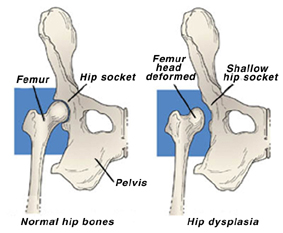
Hip dysplasia is a disease of the hip in which the ball and socket joint is malformed. This malformation means that the ball portion and its socket don’t properly meet which results in a joint that rubs and grinds against each other instead of sliding smoothly. If left undiagnosed and untreated, this instability causes abnormal wear of the hip cartilage and ultimately progresses to osteoarthritis or degenerative joint disease. Signs of this condition are pain in hip joints, reluctance to get up or exercise, difficulty climbing stairs, a “bunny-hopping” or swaying gait, limping, decreased range of motion in the hip joints, loss of muscle mass in thigh muscles and lameness, especially after periods of inactivity or exercise.
Hip dysplasia is most common in large and giant breed dogs; however, smaller dogs can also be affected. Although genetics often play a role in this disorder, young dogs that grow or gain weight too quickly or get too much high-impact exercise are also at risk of developing hip dysplasia.
An evaluation for hip dysplasia will include a physical examination, radiographs and manual tests on your dog’s hips. We can help prevent or slow this condition by monitoring food intake and ensuring that your dog gets proper exercise as he or she ages, but because hip dysplasia is an inherited defect there are no products that can prevent its development. There are several surgical options, including a complete hip replacement. However, a combination of healthy diet, maintaining a normal weight, exercise, massage, warm and dry sleeping areas, joint supplements, and, potentially, prescription veterinary pain-relieving medication can help manage the condition. The earlier we can diagnose hip dysplasia, the better the possible outcome will be for your dog.
Please call us to discuss your dog’s risk of developing hip dysplasia, to schedule a screening, or to discuss treatment options.




